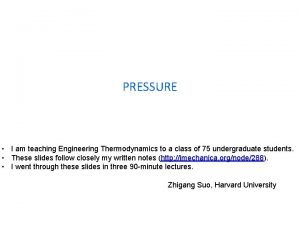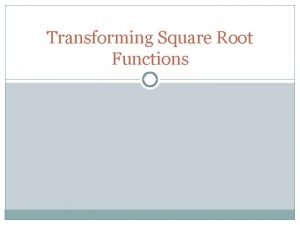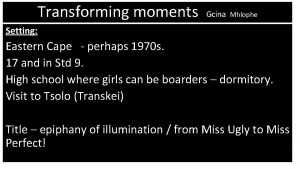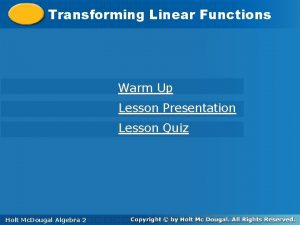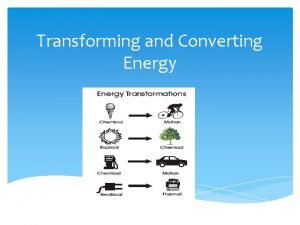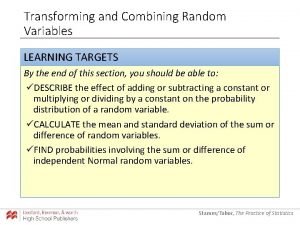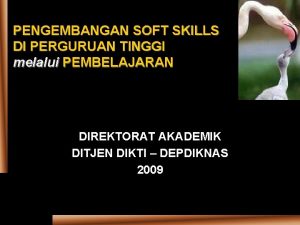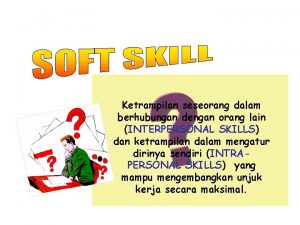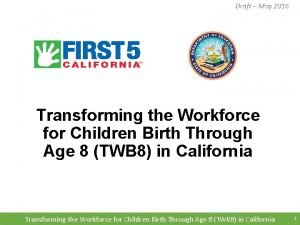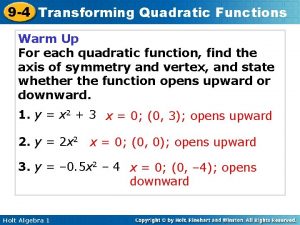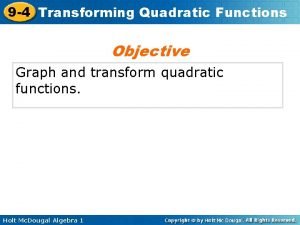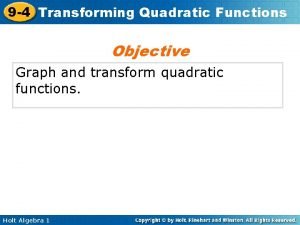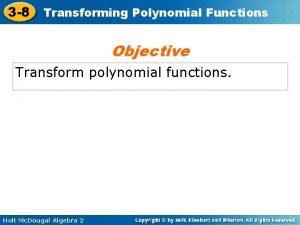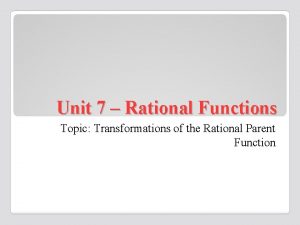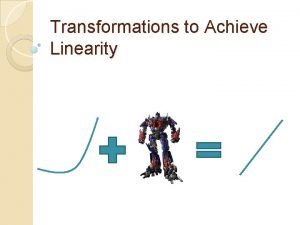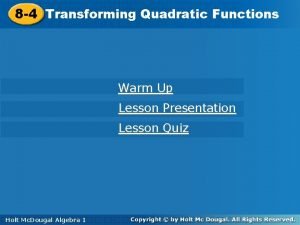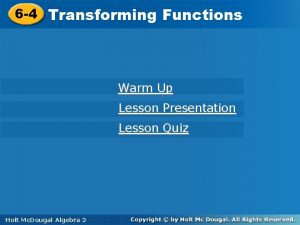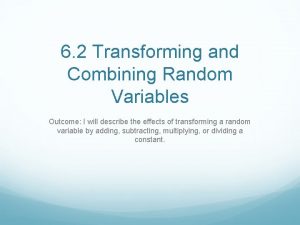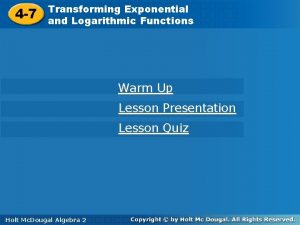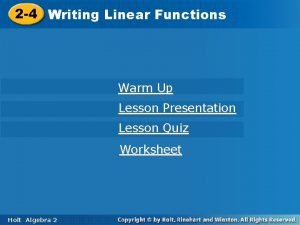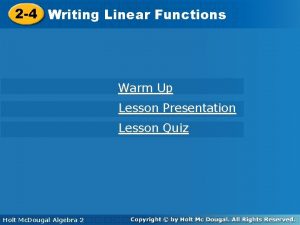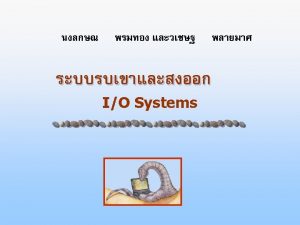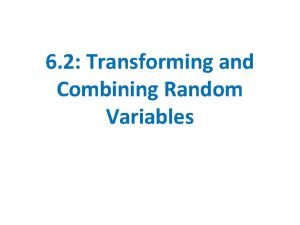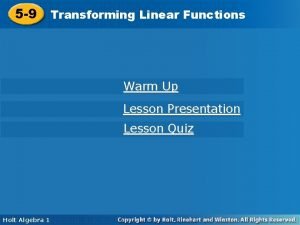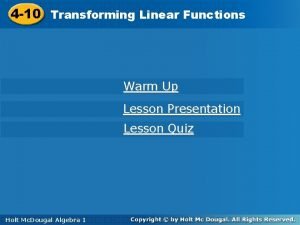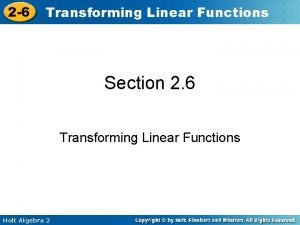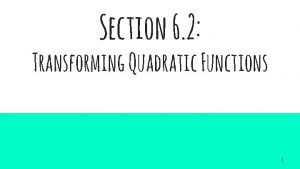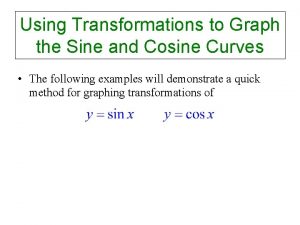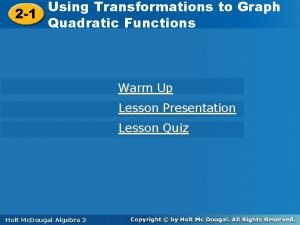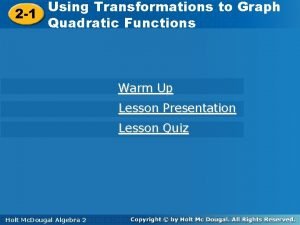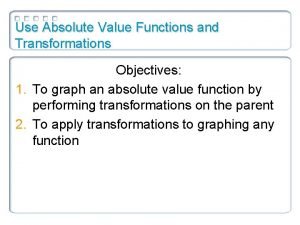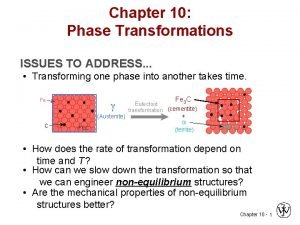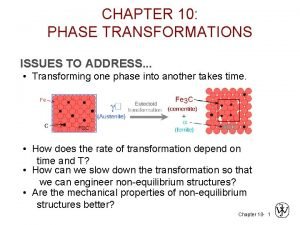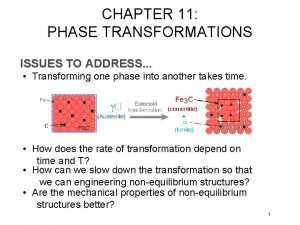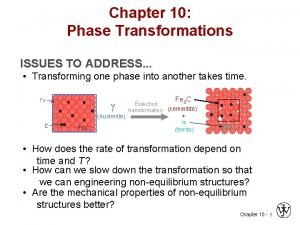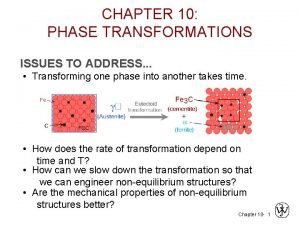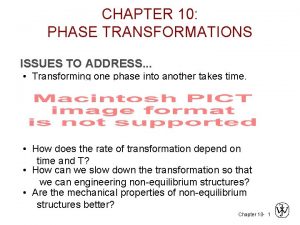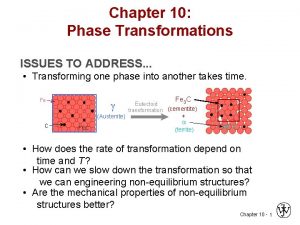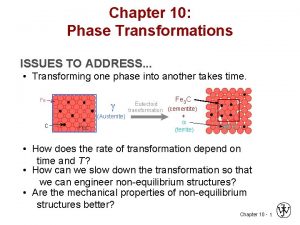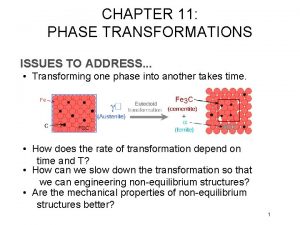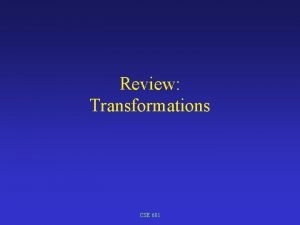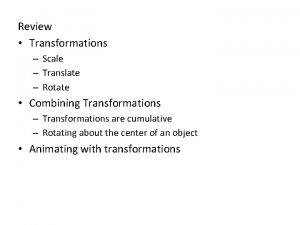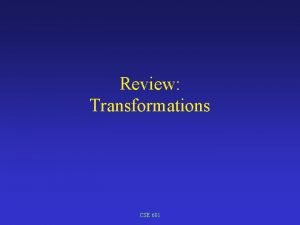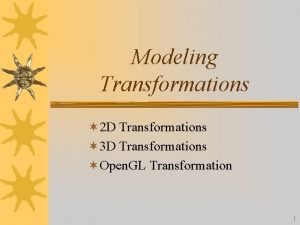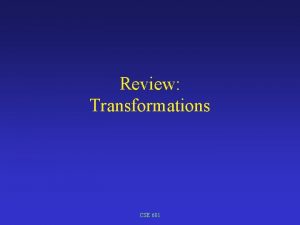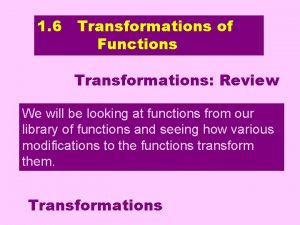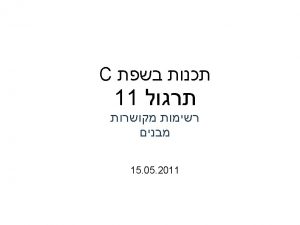PHASE TRANSFORMATIONS ISSUES TO ADDRESS Transforming one phase














































































- Slides: 78

PHASE TRANSFORMATIONS ISSUES TO ADDRESS. . . • Transforming one phase into another takes time. • How does the rate of transformation depend on time and T? • How can we slow down the transformation so that we can engineering non-equilibrium structures? • Are the mechanical properties of non-equilibrium structures better? 1

FRACTION OF TRANSFORMATION • Fraction transformed depends on time. Adapted from Fig. 10. 1, Callister 6 e. • Transformation rate depends on T. Adapted from Fig. 10. 2, Callister 6 e. (Fig. 10. 2 adapted from B. F. Decker and D. Harker, "Recrystallization in Rolled Copper", Trans AIME, 188, 1950, p. 888. ) • r often small: equil not possible! 2

TRANSFORMATIONS & UNDERCOOLING Adapted from Fig. 9. 21, Callister 6 e. (Fig. 9. 21 adapted from Binary Alloy Phase Diagrams, 2 nd ed. , Vol. 1, T. B. Massalski (Ed. -in -Chief), ASM International, Materials Park, OH, 1990. ) 3

EUTECTOID TRANSFORMATION RATE ~ DT • Growth of pearlite from austenite: Adapted from Fig. 9. 13, Callister 6 e. • Reaction rate increases with DT. Adapted from Fig. 10. 3, Callister 6 e. 4

NUCLEATION AND GROWTH • Reaction rate is a result of nucleation and growth of crystals. Adapted from Fig. 10. 1, Callister 6 e. • Examples: 5








ISOTHERMAL TRANSFORMATION DIAGRAMS • Fe-C system, Co = 0. 77 wt%C • Transformation at T = 675 C. Adapted from Fig. 10. 4, Callister 6 e. (Fig. 10. 4 adapted from H. Boyer (Ed. ) Atlas of Isothermal Transformation and Cooling Transformation Diagrams, American Society for Metals, 1977, p. 369. ) 6

EX: COOLING HISTORY Fe-C SYSTEM • Eutectoid composition, Co = 0. 77 wt%C • Begin at T > 727 C • Rapidly cool to 625 C and hold isothermally. Adapted from Fig. 10. 5, Callister 6 e. (Fig. 10. 5 adapted from H. Boyer (Ed. ) Atlas of Isothermal Transformation and Cooling Transformation Diagrams, American Society for Metals, 1997, p. 28. ) 7

PEARLITE MORPHOLOGY Two cases: • Ttransf just below TE --Larger T: diffusion is faster --Pearlite is coarser. • Ttransf well below TE --Smaller T: diffusion is slower --Pearlite is finer. Adapted from Fig. 10. 6 (a) and (b), Callister 6 e. (Fig. 10. 6 from R. M. Ralls et al. , An Introduction to Materials Science and Engineering, p. 361, John Wiley and Sons, Inc. , New York, 1976. ) 8

NON-EQUIL TRANSFORMATION PRODUCTS: Fe-C • Bainite: --a lathes (strips) with long rods of Fe 3 C --diffusion controlled. • Isothermal Transf. Diagram (Adapted from Fig. 10. 8, Callister, 6 e. (Fig. 10. 8 from Metals Handbook, 8 th ed. , Vol. 8, Metallography, Structures, and Phase Diagrams, American Society for Metals, Materials Park, OH, 1973. ) Adapted from Fig. 10. 9, Callister 6 e. (Fig. 10. 9 adapted from H. Boyer (Ed. ) Atlas of Isothermal Transformation and Cooling Transformation Diagrams, American Society for Metals, 1997, p. 28. ) 9

OTHER PRODUCTS: Fe-C SYSTEM (1) • Spheroidite: --a crystals with spherical Fe 3 C --diffusion dependent. --heat bainite or pearlite for long times --reduces interfacial area (driving force) • Isothermal Transf. Diagram (Adapted from Fig. 10, Callister, 6 e. (Fig. 10 copyright United States Steel Corporation, 1971. ) Adapted from Fig. 10. 9, Callister 6 e. (Fig. 10. 9 adapted from H. Boyer (Ed. ) Atlas of Isothermal Transformation and Cooling Transformation Diagrams, American Society for Metals, 1997, p. 28. ) 10

OTHER PRODUCTS: Fe-C SYSTEM (2) • Martensite: --g(FCC) to Martensite (BCT) (Adapted from Fig. 10. 11, Callister, 6 e. • Isothermal Transf. Diagram (Adapted from Fig. 10. 12, Callister, 6 e. (Fig. 10. 12 courtesy United States Steel Corporation. ) Adapted from Fig. 10. 13, Callister 6 e. • g to M transformation. . -- is rapid! -- % transf. depends on T only. 11

COOLING EX: Fe-C SYSTEM (1) Adapted from Fig. 10. 15, Callister 6 e. 12

COOLING EX: Fe-C SYSTEM (2) Adapted from Fig. 10. 15, Callister 6 e. 13

COOLING EX: Fe-C SYSTEM (3) Adapted from Fig. 10. 15, Callister 6 e. 14

MECHANICAL PROP: Fe-C SYSTEM (1) Adapted from Fig. 9. 27, Callister 6 e. (Fig. 9. 27 courtesy Republic Steel Corporation. ) Adapted from Fig. 9. 30, Callister 6 e. (Fig. 9. 30 copyright 1971 by United States Steel Corporation. ) Adapted from Fig. 10. 20, Callister 6 e. (Fig. 10. 20 based on data from Metals Handbook: Heat Treating, Vol. 4, 9 th ed. , V. Masseria (Managing Ed. ), American Society for Metals, 1981, p. 9. ) 15

MECHANICAL PROP: Fe-C SYSTEM (2) Adapted from Fig. 10. 21, Callister 6 e. (Fig. 10. 21 based on data from Metals Handbook: Heat Treating, Vol. 4, 9 th ed. , V. Masseria (Managing Ed. ), American Society for Metals, 1981, pp. 9 and 17. ) 16

MECHANICAL PROP: Fe-C SYSTEM (3) • Fine Pearlite vs Martensite: Adapted from Fig. 10. 23, Callister 6 e. (Fig. 10. 23 adapted from Edgar C. Bain, Functions of the Alloying Elements in Steel, American Society for Metals, 1939, p. 36; and R. A. Grange, C. R. Hribal, and L. F. Porter, Metall. Trans. A, Vol. 8 A, p. 1776. ) • Hardness: fine pearlite << martensite. 17

TEMPERING MARTENSITE • reduces brittleness of martensite, • reduces internal stress caused by quenching. Adapted from Fig. 10. 25, Callister 6 e. (Fig. 10. 25 adapted from Fig. furnished courtesy of Republic Steel Corporation. ) Adapted from Fig. 10. 24, Callister 6 e. (Fig. 10. 24 copyright by United States Steel Corporation, 1971. ) 18

SUMMARY: PROCESSING OPTIONS Adapted from Fig. 10. 27, Callister 6 e. 19





















HARDENABILITY--STEELS • Ability to form martensite • Jominy end quench test to measure hardenability. Adapted from Fig. 11. 10, Callister 6 e. (Fig. 11. 10 adapted from A. G. Guy, Essentials of Materials Science, Mc. Graw-Hill Book Company, New York, 1978. ) • Hardness versus distance from the quenched end. Adapted from Fig. 11, Callister 6 e. 8

WHY HARDNESS CHANGES W/ POSITION • The cooling rate varies with position. Adapted from Fig. 11. 12, Callister 6 e. (Fig. 11. 12 adapted from H. Boyer (Ed. ) Atlas of Isothermal Transformation and Cooling Transformation Diagrams, American Society for Metals, 1977, p. 376. ) 9

HARDENABILITY VS ALLOY CONTENT • Jominy end quench results, C = 0. 4 wt%C Adapted from Fig. 11. 13, Callister 6 e. (Fig. 11. 13 adapted from figure furnished courtesy Republic Steel Corporation. ) • "Alloy Steels" (4140, 4340, 5140, 8640) --contain Ni, Cr, Mo (0. 2 to 2 wt%) --these elements shift the "nose". --martensite is easier to form. 13

QUENCHING MEDIUM & GEOMETRY • Effect of quenching medium: Medium air oil water Severity of Quench small moderate large Hardness small moderate large • Effect of geometry: When surface-to-volume ratio increases: --cooling rate increases --hardness increases Position center surface Cooling rate small large Hardness small large 11

PREDICTING HARDNESS PROFILES • Ex: Round bar, 1040 steel, water quenched, 2" diam. Adapted from Fig. 11. 18, Callister 6 e. 12

















The Pressurized Water Reactor (PWR)



INTERGRANULAR CORROSION GRAIN BOUNDARY SENSITIZATION Cr-depleted alloy at grain boundaries is anodic to the surrounding grains. High cathode/anode surface area ratio results in rapid microscopic galvanic attack and IGC at grain boundaries. To prevent sensitization 1. Lower carbon level 2. Add carbide formers 3. Heat treatment Carbide precipitation at grain boundary during sensitization in stainless steel heated in the temperature range 510 C 788 C

Weld Decay in Stainless Steels






 Physical address vs logical address
Physical address vs logical address Explain how dishes on a menu address environmental issues.
Explain how dishes on a menu address environmental issues. Eduqas hospitality and catering
Eduqas hospitality and catering Transforming polynomial functions quiz part 2
Transforming polynomial functions quiz part 2 One god one empire one religion
One god one empire one religion One one one little dog run
One one one little dog run One king one law one faith
One king one law one faith One empire one god one emperor
One empire one god one emperor One ford behaviors
One ford behaviors See one do one teach one
See one do one teach one See one, do one, teach one
See one, do one, teach one Willow cabin speech
Willow cabin speech Studiendekanat uni bonn
Studiendekanat uni bonn One vision one identity one community
One vision one identity one community Graphic organizer with the aims of la liga filipina
Graphic organizer with the aims of la liga filipina Effects of rentals to filipino entrepreneurs
Effects of rentals to filipino entrepreneurs Normal phase vs reverse phase chromatography
Normal phase vs reverse phase chromatography Hplc reverse phase vs normal phase
Hplc reverse phase vs normal phase Mobile phase and stationary phase
Mobile phase and stationary phase Mobile phase in chromatography
Mobile phase in chromatography Normal phase vs reverse phase chromatography
Normal phase vs reverse phase chromatography Power formula three phase
Power formula three phase Hplc detector types
Hplc detector types Phase to phase voltage
Phase to phase voltage Csce 441
Csce 441 Stage 1 denial
Stage 1 denial Vaporfix
Vaporfix Transformation of square root function
Transformation of square root function Transforming patient experience
Transforming patient experience Analysis of transforming moments
Analysis of transforming moments Lesson 6-4 transforming linear functions answer key
Lesson 6-4 transforming linear functions answer key Transformation of energy of doorbell
Transformation of energy of doorbell Combining random variables
Combining random variables Contoh transforming beliefs
Contoh transforming beliefs What is transforming resources
What is transforming resources The unit that transforms data into information is the:
The unit that transforms data into information is the: Contoh transforming beliefs
Contoh transforming beliefs Graph transformations worksheet
Graph transformations worksheet Transforming the workforce
Transforming the workforce How to convert unstructured data into structured data
How to convert unstructured data into structured data 9-4 transforming quadratic functions
9-4 transforming quadratic functions Narrowest graph example
Narrowest graph example Example of narrowest graph
Example of narrowest graph Polynomial graph transformations
Polynomial graph transformations Rational function transformations
Rational function transformations Transforming school culture: how to overcome staff division
Transforming school culture: how to overcome staff division Transforming thoughts ideas and
Transforming thoughts ideas and Transforming to achieve linearity
Transforming to achieve linearity Transforming and combining random variables
Transforming and combining random variables 8-4 modeling with quadratic functions
8-4 modeling with quadratic functions Transforming linear functions lesson 6-4
Transforming linear functions lesson 6-4 Combining normal random variables
Combining normal random variables Lesson 4-10 transforming linear functions answers
Lesson 4-10 transforming linear functions answers Transforming exponential and logarithmic functions
Transforming exponential and logarithmic functions Writing functions
Writing functions 2-4 writing linear equations
2-4 writing linear equations Transforming teacher education through clinical practice
Transforming teacher education through clinical practice Dr anthony muhammad transforming school culture
Dr anthony muhammad transforming school culture 6-4 transforming linear functions
6-4 transforming linear functions Transforming i/o requests to hardware operations
Transforming i/o requests to hardware operations Pete's jeep tours offers a popular
Pete's jeep tours offers a popular Linear function transformations
Linear function transformations Lesson 6-4 transforming linear functions answer key
Lesson 6-4 transforming linear functions answer key Transforming linear functions lesson 6-4
Transforming linear functions lesson 6-4 Transforming nursing roles
Transforming nursing roles Transforming security operations
Transforming security operations Forces transforming the service economy
Forces transforming the service economy Mitre drug test
Mitre drug test A burning candle is in the process of transforming -
A burning candle is in the process of transforming - Transforming school culture
Transforming school culture Transforming quadratic functions
Transforming quadratic functions Transforming data into information in computer
Transforming data into information in computer Lesson 11 transforming the graph of the sine function
Lesson 11 transforming the graph of the sine function Improving hr service delivery
Improving hr service delivery Service marketing chapter 1
Service marketing chapter 1 Sine and cosine graphs
Sine and cosine graphs Transformations of quadratic functions
Transformations of quadratic functions Transformations of quadratic graphs
Transformations of quadratic graphs Absolute value graph transformations
Absolute value graph transformations


























